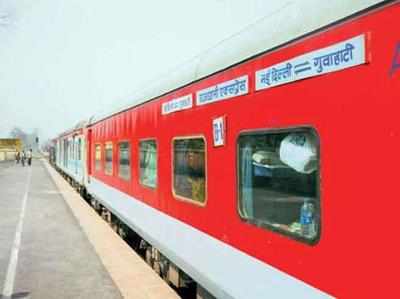- News
- India News
- <arttitle><em/>Railways defends surge pricing, says it's flexi-pricing</arttitle>
Trending
This story is from September 10, 2016
Railways defends surge pricing, says it's flexi-pricing
The Railways has clarified that the recently introduced flexi-fare system on Rajdhani, Shatabdi and Duronto trains is only an experimental measure and is not surge pricing.The new system will affect less than 0.15 million passengers out of total 23 million passengers, it said.

BENGALURU: The Railways has clarified that the recently introduced flexi-fare system on Rajdhani, Shatabdi and Duronto trains is only an experimental measure and is not surge pricing.
In a statement, the Railways has claimed that 142 trains (mainly high-end) out of about 12,500 total trains and 3,200 mail express trains will be chosen for this experiment and the same accounts to 1.1% of total trains and 4.4% of mail/express trains.The recovery from this measure would only be to the extent of Rs 400 crore in the current year.
The new system will affect less than 0.15 million (mainly high-end) passengers out of total 23 million passengers carried by the Indian railways daily, it said.
“Lower-end common man is not affected by this experiment. 99% of the trains which carry 99.35% of our passengers are not impacted by this scheme. For the common man, rail fares remain much more competitive as compared to road,” reads a portion of the statement. It also expresses confidence that customers would continue to patronize rail transport.
“In contrast, the recovery is Rs 1.55 on each freight NTKM as against a cost of 99 paise per NTKM. And as a result of this subsidization of passenger services, the Indian Railways bore a loss of 33,490 crore on coaching services,” the statement explained.
Adding further, the statement says that Russia, the UK, France, American and Japanese railways have been following dynamic pricing for long and other service providers like airlines, hotels, car rentals, retailers especially e-commerce, etc have also adopted dynamic pricing.
In a statement, the Railways has claimed that 142 trains (mainly high-end) out of about 12,500 total trains and 3,200 mail express trains will be chosen for this experiment and the same accounts to 1.1% of total trains and 4.4% of mail/express trains.The recovery from this measure would only be to the extent of Rs 400 crore in the current year.
The new system will affect less than 0.15 million (mainly high-end) passengers out of total 23 million passengers carried by the Indian railways daily, it said.
“Lower-end common man is not affected by this experiment. 99% of the trains which carry 99.35% of our passengers are not impacted by this scheme. For the common man, rail fares remain much more competitive as compared to road,” reads a portion of the statement. It also expresses confidence that customers would continue to patronize rail transport.
The railways further contended that their passenger services are highly subsidized and as against a passenger cost of 73 paise, they recover only 37 paise per km.
“In contrast, the recovery is Rs 1.55 on each freight NTKM as against a cost of 99 paise per NTKM. And as a result of this subsidization of passenger services, the Indian Railways bore a loss of 33,490 crore on coaching services,” the statement explained.
Adding further, the statement says that Russia, the UK, France, American and Japanese railways have been following dynamic pricing for long and other service providers like airlines, hotels, car rentals, retailers especially e-commerce, etc have also adopted dynamic pricing.
End of Article
FOLLOW US ON SOCIAL MEDIA










